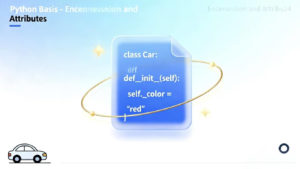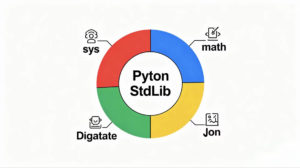Modules & Packages (import, from, main)
Project: Build a modular “Math & Greeting Toolkit” that imports and reuses your own functions.
01. Learning Goal
By the end of this lesson, you will be able to:
- Understand what modules and packages are
- Import both built-in and custom Python modules
- Use from-import, aliasing, and main effectively
- Organize your code for reusability and clarity
02. Problem Scenario
As your projects grow, you’ll want to organize your code into smaller, reusable files.
Instead of putting everything into one Python file, you’ll learn to use modules and packages to make your project scalable and clean.
03. Step 1 – What is a Module?
A module is simply a Python file (.py) that contains functions, classes, or variables.
You can import it into another file to reuse its code.
Example: using Python’s built-in math module
import math
print(math.sqrt(16)) # 4.0
print(math.pi) # 3.141592...04. Step 2 – Different Ways to Import
You can import modules in multiple ways depending on your use case.
# Import the entire module
import math
print(math.sqrt(25))
# Import specific functions
from math import sqrt, pi
print(sqrt(25), pi)
# Use an alias for convenience
import math as m
print(m.sqrt(36))05. Step 3 – Creating Your Own Module
You can create your own Python file and reuse it as a module.
calc.py
def add(a, b):
return a + b
def sub(a, b):
return a - bmain.py
import calc
print(calc.add(3, 5)) # 8
print(calc.sub(10, 7)) # 3When you import calc, Python automatically runs that file once and gives access to its functions.
06. Step 4 – What is a Package?
A package is a folder that contains multiple modules.
It must include an __init__.py file to be recognized as a package.
my_package/
__init__.py
math_ops.py
string_ops.pyfrom my_package import math_ops
print(math_ops.add(2, 3))Packages make it easy to group related modules together for large-scale projects.
07. Step 5 – The __name__ and __main__ Check
Every Python file can act as either:
- A script (run directly)
- A module (imported into another file)
You can distinguish them using if __name__ == "__main__":
# test.py
def hello():
print("Hello!")
if __name__ == "__main__":
hello()When executed directly:
$ python test.py
Hello!When imported:
import test
# Does not print automaticallyThis allows you to include test code or demos that run only when executed directly.
08. Step 6 – Installing External Libraries
You can install third-party libraries using pip.
pip install requestsThen, use it in your project:
import requests
res = requests.get("https://api.github.com")
print(res.status_code)09. Step 7 – Practice Examples
Example 1: Standard Module
import random
print(random.randint(1, 6)) # Roll a diceExample 2: Custom Module
greet.py
def say_hello(name):
return f"Hello, {name}!"main.py
import greet
print(greet.say_hello("Sabin"))10. Step 8 – Mini Project: Math & Greeting Toolkit
Let’s build a simple package that combines math and greeting modules.
project structure
toolkit/
__init__.py
math_tools.py
greet_tools.py
main.pymath_tools.py
def add(a, b):
return a + b
def multiply(a, b):
return a * bgreet_tools.py
def greet(name):
return f"Welcome, {name}!"main.py
from toolkit import math_tools, greet_tools
print(math_tools.add(10, 5))
print(greet_tools.greet("Sabin"))Output:
15
Welcome, Sabin!11. Reflection
You have learned how to:
- Import built-in and custom modules
- Organize multiple files into packages
- Use
__main__to separate test code from imports - Build your own Math & Greeting Toolkit for reusable code


